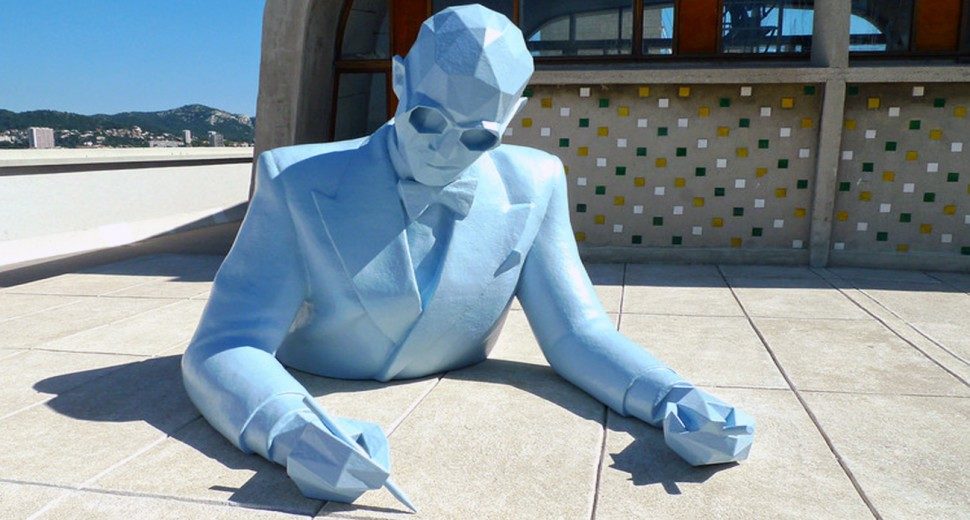Presse, Juin 2013
Photos © Olivier Amsellem & © Xavier Veilhan
French designer Ora-Ïto opens a contemporary art center atop Marseille's landmark Cité Radieuse.
THREE YEARS AGO, French designer Ora-Ïto and artist Xavier Veilhan were cruising along the coast of Marseille in a small wooden fisherman’s boat when the Le Corbusier landmark building, La Cité Radieuse, came into view. Mr. Veilhan gazed at the impressive silhouette of the towering modernist concrete housing unit on stilts. “I’ve always dreamed of having a show there,” the artist said to his friend. “You’re in luck,” Ora-Ïto told him. “I just bought the rooftop terrace.”
Now, after a long, laborious restoration, the MaMo (short for “Marseille Modular,” marseille-citeradieuse.org) opens June 8.
This new contemporary art center—a 600-square-meter indoor/outdoor space that includes the former gym, running track and solarium of Le Corbusier’s 1947 Cité Radieuse—opens its doors with “Architectones.” The show features Mr. Veilhan’s latest sculptures and installations, all made for the space.
The MaMo’s three-year restoration project, costing several “hundred thousands of euros,” was jointly funded by Ora-Ïto and the building’s co-owners. It is something of an anomaly, a cross between a private museum, sponsored by Audi Talents Awards, and a historic architectural Mecca. It also remains a public space for the residents of the Cité Radieuse, whose 350 apartment units are superimposed over 18 stories like a giant jigsaw puzzle.
“When I heard the roof terrace was for sale three years ago, I jumped on it,” says the 36-year-old Marseille-born designer, whose real name is Ito Morabito. “I immediately sold my townhouse in Paris and my entire art collection…. People tried to discourage me. I knew I was taking the risk of buying a space without knowing whether or not I could do anything with it.”
At Ora-Ïto’s request, 1,200 co-owners took a vote and the designer was given a green light to move forward with the art center. The biggest challenge in the restoration, he explains, was removing a decaying extension (dubbed “the wart”) that had been added to the 200-square-meter gym. Once the unsightly extension was removed, it was a joy, he says, to uncover Le Corbusier’s original glass facade: a Mondrian-inspired assemblage of rectangles and squares, conceived with the utmost precision.
The materials used in reconstruction were all perfect matches with the original wood. “Every time I heard about an auction with anything from Marseille, I bought it,” Ora-Ïto recounts. “I’ve got all kinds of doors, entire kitchens, and office furniture, signed by Le Corbusier and his two collaborators, Charlotte Perriand and Jean Prouvé…. They were the dream team of the ’50s”
Working closely with France’s national team in charge of the restoration of historical monuments, Ora-Ïto also has plans to open a café, bookstore and artist residences on the site. “We’re delighted that the rooftop and gym will permit visitors to rediscover the original architecture,” says Michel Richard, director of the Fondation Le Corbusier in Paris. “The MaMo also renews the tradition of avant-garde performances and art shows on the roof, which was Le Corbusier’s wish. During the mid-’50s and early ’60s, everyone performed there from Maurice Béjart to Olivier Messiaen. ”
An autodidact and design-school dropout, Ora-Ïto comes from a family of artists and architects. His father, Pascal Morabito, is a well-known designer.
Ora-Ïto made his mark at 19 by dreaming up fake products of real brands on the Internet. These days, he is known for quirky creations for big-name brands—Adidas water bottles, Heineken aluminum bottles, Guzzini kitchen accessories, Artemide lamps, Christofle tables and Cappellini furniture.
“I’ve had to slow down a little,” Ora-Ïto says. “The MaMo has been a full-time sport. They used to call Le Corbusier ‘le fada’ [the madman] when he first built the Cité Radieuse. Now the Marseillais are calling me that as well.”
Article by Lanie Goodman

